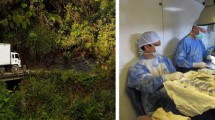Abstract
A program of intermittent surgical services utilized a mobile facility to support multiple primary care sites in Ecuador. The fiscal and clinical outcomes of the program were analyzed. From 1994 to 2003 the mobile program responded to requests from 15 of 22 provinces of Ecuador for surgical care. The sites served could not offer permanent surgical care. Criteria for inclusion and follow-up were set. Medical records were kept in accordance with standards of the Ministry of Health. Standards of care and critical care pathways were instituted. The program had a permanent staff supplemented by volunteers. Cases were recorded and outcomes noted with respect to complications. The cost of the surgical aspect of the program was entirely covered by a foundation through donations and public service contracts. Financial records of the foundation were reviewed and the costs analyzed. A total of 4545 operations were done largely in general surgery specialties. The program made 40 to 50 excursions each year and proved to be a stable element of medical care delivery. There were no deaths, four major complications, and three minor complications. The cost per operation was less than $100. Comparison to U.S. and international volunteer organizations are reported. This program of intermittent mobile surgical services in coordination with fixed primary care constitutes a sustainable, high quality clinical program fully integrated into existing care of a national health ministry. In-country resources may provide greatly enhanced services at low cost and should be considered as an alternative.





Similar content being viewed by others

References
Rural Public Health: Issues and Considerations. A Report to the Secretary U.S. Department of Health and Human Services. The National Advisory Committee on Rural Health. February 2000
American College of Surgeons Statements of Principles. Accessed February 13, 2004 (http://www.facs.org/fellows_info/statements/statement.html)
Woodard SC. The AMSUS History of Military Medicine Essay Award: the story of the mobile army surgical hospital. Mil. Med. 2003;168:503–513
Bulletin from the UK Department of Health. UK—Speedier surgery for thousands of patients. Accessed January 13, 2004 (http://www.medicalnewstodav.com/index.php?newsid=5299)
Loviglio J. Groups warn against mobile eye clinics (http://www.centredaily.com/mld/centredaily/news/7206098.htm)
Blanchard RJ, Merrell RC, Geelhoed GW, et al. Training to serve unmet surgical needs worldwide. J. Am. Coll. Surg. 2001;193:417–427
Operation smile. Accessed February 20, 2004 (http://www.operationsmile.org/aboutus/quickfacts.html)
Interplast. Accessed February 20, 2004 (http://www.interplast.org/donate/index.html)
World Health Organization. Ecuador. Accessed February 18, 2004 (http://www.who.int/country/ecu/en/)
Cinterandes Foundation Summary Report 2003. February 2004. Cuenca, Ecuador
Acknowledgment
This work was funded in part by a grant from NASA.
Author information
Authors and Affiliations
Corresponding author
Rights and permissions
About this article
Cite this article
Rodas, E., Vicuña, A. & Merrell, R.C. Intermittent and Mobile Surgical Services: Logistics and Outcomes. World J. Surg. 29, 1335–1339 (2005). https://doi.org/10.1007/s00268-005-7632-4
Published:
Issue Date:
DOI: https://doi.org/10.1007/s00268-005-7632-4



